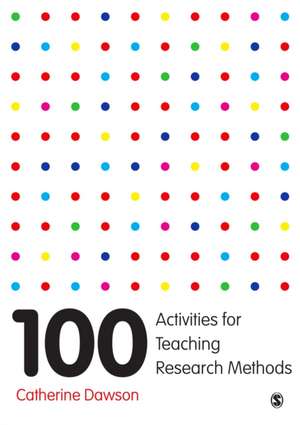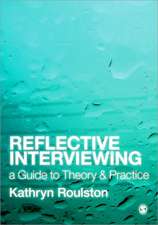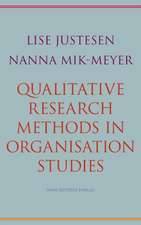100 Activities for Teaching Research Methods
Autor Catherine Dawsonen Limba Engleză Hardback – 21 aug 2016
Developed to complement and enhance existing course materials, the 100 ready-to-use activities encourage innovative and engaging classroom practice in seven areas:
- finding and using sources of information
- planning a research project
- conducting research
- using and analyzing data
- disseminating results
- acting ethically
- developing deeper research skills.
Not only does the A4 format make the student handouts easy to photocopy, they are also available to download and print directly from the book’s companion website for easy distribution in class.
| Toate formatele și edițiile | Preț | Express |
|---|---|---|
| Paperback (1) | 365.07 lei 3-5 săpt. | +38.31 lei 7-13 zile |
| SAGE Publications – 21 aug 2016 | 365.07 lei 3-5 săpt. | +38.31 lei 7-13 zile |
| Hardback (1) | 1184.24 lei 6-8 săpt. | |
| SAGE Publications – 21 aug 2016 | 1184.24 lei 6-8 săpt. |
Preț: 1184.24 lei
Preț vechi: 1444.20 lei
-18% Nou
Puncte Express: 1776
Preț estimativ în valută:
226.71€ • 233.28$ • 191.10£
226.71€ • 233.28$ • 191.10£
Carte tipărită la comandă
Livrare economică 28 februarie-14 martie
Preluare comenzi: 021 569.72.76
Specificații
ISBN-13: 9781473946286
ISBN-10: 147394628X
Pagini: 384
Dimensiuni: 210 x 297 x 27 mm
Greutate: 1.2 kg
Ediția:First Edition
Editura: SAGE Publications
Colecția Sage Publications Ltd
Locul publicării:London, United Kingdom
ISBN-10: 147394628X
Pagini: 384
Dimensiuni: 210 x 297 x 27 mm
Greutate: 1.2 kg
Ediția:First Edition
Editura: SAGE Publications
Colecția Sage Publications Ltd
Locul publicării:London, United Kingdom
Recenzii
Catherine's book is a fantastic resource for anyone who is teaching research methods in the social sciences. Covering all aspects of the research process, it is packed full of innovative ideas, useful tips, and structured activities for use within the classroom. If you are a tutor, teacher, or lecturer who is looking to provide interesting and engaging content for your students, this book is an absolute 'must have'.
Every university with a Social Science department has to deliver research methods in some capacity, but there is no need for us all to sit in our institutional silos and reinvent the wheel. Dawson provides a huge and varied list of pre-designed activities for methods teachers to draw upon covering the whole research process and an eclectic range of methodological approaches. The activities are pedagogically engaging, comprehensively resourced and provide us with an opportunity to rethink how social science research methods can be taught in a more interactive and engaging way.
Every university with a Social Science department has to deliver research methods in some capacity, but there is no need for us all to sit in our institutional silos and reinvent the wheel. Dawson provides a huge and varied list of pre-designed activities for methods teachers to draw upon covering the whole research process and an eclectic range of methodological approaches. The activities are pedagogically engaging, comprehensively resourced and provide us with an opportunity to rethink how social science research methods can be taught in a more interactive and engaging way.
Cuprins
INTRODUCTION
SECTION 1: FINDING AND USING SOURCES OF INFORMATION
Activity 1: Distinguishing between Primary and Secondary Sources
Activity 2: Finding and Using Primary Sources
Activity 3: Improving Observation Skills
Activity 4: Assessing Prior Experience and Learning
Activity 5: Reflecting on Your Enquiry Skills
Activity 6: Using the Internet for Background Research
Activity 7: Evaluating Sources
Activity 8: Recognizing Statistics, Facts, Arguments and Opinions
Activity 9: Discovering Questionable Statistics Published Online
Activity 10: Managing Critiques and Reviews
Activity 11: Critiquing Quantitative Research Papers
Activity 12: Critiquing Qualitative Research Papers
Activity 13: Evaluating Science in the Media
Activity 14: Recognizing Media and Political Bias
Activity 15: Recognizing Research(er) Bias
SECTION 2: PLANNING A RESEARCH PROJECT
Activity 16: Choosing a Research Topic
Activity 17: Producing Aims and Objectives
Activity 18: Developing a Research Question
Activity 19: Designing a Research Project
Activity 20: Choosing Research Methods
Activity 21: Using Multiple or Mixed Approaches
Activity 22: Knowing About Probability Samples
Activity 23: Knowing About Non-Probability (Purposive) Samples
Activity 24: Choosing Sample Size
Activity 25: Avoiding Sampling Problems
Activity 26: Justifying Your Research Topic
Activity 27: Defending Methodology
Activity 28: Costing a Research Project
Activity 29: Producing and Justifying Your Budget
Activity 30: Producing a Research Proposal
Activity 31: Obtaining Funding
Activity 32: Working Collaboratively With Others
SECTION 3: CONDUCTING RESEARCH
Activity 33: Understanding the Process of Science
Activity 34: Knowing About Real-World Scientific Research
Activity 35: Avoiding Mistakes in Experiments
Activity 36: Undertaking Ethnographic Work
Activity 37: Conducting Interviews
Activity 38: Constructing Questions
Activity 39: Producing an Interview Schedule
Activity 40: Running a Focus Group
Activity 41: Establishing Rapport
Activity 42: Listening to Interviewees
Activity 43: Understanding Group Dynamics
Activity 44: Recording Techniques
Activity 45: Using Observation Techniques
Activity 46: Using Visual Methods
Activity 47: Designing Questionnaires
Activity 48: Administering Questionnaires
Activity 49: Improving Response Rates
Activity 50: Using the Internet as a Tool for Research
SECTION 4: USING AND ANALYSING DATA
Activity 51: Reading Scientific Material
Activity 52: Improving Data Search Techniques
Activity 53: Storing and Using Data
Activity 54: Making Use of Statistics
Activity 55: Choosing Software for Statistical Analysis
Activity 56: Finding and Using Datasets
Activity 57: Analysing Quantitative Data
Activity 58: Operationalizing and Classifying
Activity 59: Ensuring Validity and Reliability in Quantitative Research
Activity 60: Understanding Data Management
Activity 61: Analysing Qualitative Data
Activity 62: Analysing Visual Data
Activity 63: Coding and Categorizing Qualitative Data
Activity 64: Evaluating Qualitative Analyses
Activity 65: Drawing Conclusions from Qualitative Data
Activity 66: Knowing About Data Protection
SECTION 5: DISSEMINATING RESULTS
Activity 67: Presenting to a Lay Audience
Activity 68: Dealing With the Media
Activity 69: Presenting Conference Papers
Activity 70: Writing Journal Papers
Activity 71: Disseminating via Social Media
Activity 72: Publishing Online
Activity 73: Writing an Impact Statement
Activity 75: Planning and Writing a Dissertation
Activity 74: Overcoming Writer's Block
SECTION 6: ACTING ETHICALLY
Activity 76: Recognizing Ethical Issues
Activity 77: Understanding Legal Requirements
Activity 78: Avoiding Plagiarism
Activity 79: Producing a Code of Ethics
Activity 80: Understanding Issues of Informed Consent
Activity 81: Treating Participants with Respect
Activity 82: Avoiding Conflict of Interest
Activity 83: Understanding Biased Financial Relationships
Activity 84: Recognizing and Managing the Funding Effect
Activity 85: Knowing about the Ethical Approval Process
Activity 86: Collaborating and Co-Operating Ethically
Activity 87: Conducting Research that Involves Risk
Activity 88: Conducting Research with Vulnerable People
Activity 89: Conducting Research with Children
SECTION 7: DEVELOPING DEEPER RESEARCH SKILLS
Activity 90: Knowing About Epistemology and Ontology
Activity 91: Asking Epistemological Questions
Activity 92: Understanding Methodology
Activity 93: Asking Methodological Questions
Activity 94: Locating Epistemological and Methodological Standpoint
Activity 95: Understanding Theoretical Perspective
Activity 96: Reasoning Inductively and Deductively
Activity 97: Recognizing Problems with Reasoning
Activity 98: Hypothesizing and Theorizing
Activity 99: Generating Theory Inductively and Deductively
Activity 100: Identifying Effective Theory
SECTION 1: FINDING AND USING SOURCES OF INFORMATION
Activity 1: Distinguishing between Primary and Secondary Sources
Activity 2: Finding and Using Primary Sources
Activity 3: Improving Observation Skills
Activity 4: Assessing Prior Experience and Learning
Activity 5: Reflecting on Your Enquiry Skills
Activity 6: Using the Internet for Background Research
Activity 7: Evaluating Sources
Activity 8: Recognizing Statistics, Facts, Arguments and Opinions
Activity 9: Discovering Questionable Statistics Published Online
Activity 10: Managing Critiques and Reviews
Activity 11: Critiquing Quantitative Research Papers
Activity 12: Critiquing Qualitative Research Papers
Activity 13: Evaluating Science in the Media
Activity 14: Recognizing Media and Political Bias
Activity 15: Recognizing Research(er) Bias
SECTION 2: PLANNING A RESEARCH PROJECT
Activity 16: Choosing a Research Topic
Activity 17: Producing Aims and Objectives
Activity 18: Developing a Research Question
Activity 19: Designing a Research Project
Activity 20: Choosing Research Methods
Activity 21: Using Multiple or Mixed Approaches
Activity 22: Knowing About Probability Samples
Activity 23: Knowing About Non-Probability (Purposive) Samples
Activity 24: Choosing Sample Size
Activity 25: Avoiding Sampling Problems
Activity 26: Justifying Your Research Topic
Activity 27: Defending Methodology
Activity 28: Costing a Research Project
Activity 29: Producing and Justifying Your Budget
Activity 30: Producing a Research Proposal
Activity 31: Obtaining Funding
Activity 32: Working Collaboratively With Others
SECTION 3: CONDUCTING RESEARCH
Activity 33: Understanding the Process of Science
Activity 34: Knowing About Real-World Scientific Research
Activity 35: Avoiding Mistakes in Experiments
Activity 36: Undertaking Ethnographic Work
Activity 37: Conducting Interviews
Activity 38: Constructing Questions
Activity 39: Producing an Interview Schedule
Activity 40: Running a Focus Group
Activity 41: Establishing Rapport
Activity 42: Listening to Interviewees
Activity 43: Understanding Group Dynamics
Activity 44: Recording Techniques
Activity 45: Using Observation Techniques
Activity 46: Using Visual Methods
Activity 47: Designing Questionnaires
Activity 48: Administering Questionnaires
Activity 49: Improving Response Rates
Activity 50: Using the Internet as a Tool for Research
SECTION 4: USING AND ANALYSING DATA
Activity 51: Reading Scientific Material
Activity 52: Improving Data Search Techniques
Activity 53: Storing and Using Data
Activity 54: Making Use of Statistics
Activity 55: Choosing Software for Statistical Analysis
Activity 56: Finding and Using Datasets
Activity 57: Analysing Quantitative Data
Activity 58: Operationalizing and Classifying
Activity 59: Ensuring Validity and Reliability in Quantitative Research
Activity 60: Understanding Data Management
Activity 61: Analysing Qualitative Data
Activity 62: Analysing Visual Data
Activity 63: Coding and Categorizing Qualitative Data
Activity 64: Evaluating Qualitative Analyses
Activity 65: Drawing Conclusions from Qualitative Data
Activity 66: Knowing About Data Protection
SECTION 5: DISSEMINATING RESULTS
Activity 67: Presenting to a Lay Audience
Activity 68: Dealing With the Media
Activity 69: Presenting Conference Papers
Activity 70: Writing Journal Papers
Activity 71: Disseminating via Social Media
Activity 72: Publishing Online
Activity 73: Writing an Impact Statement
Activity 75: Planning and Writing a Dissertation
Activity 74: Overcoming Writer's Block
SECTION 6: ACTING ETHICALLY
Activity 76: Recognizing Ethical Issues
Activity 77: Understanding Legal Requirements
Activity 78: Avoiding Plagiarism
Activity 79: Producing a Code of Ethics
Activity 80: Understanding Issues of Informed Consent
Activity 81: Treating Participants with Respect
Activity 82: Avoiding Conflict of Interest
Activity 83: Understanding Biased Financial Relationships
Activity 84: Recognizing and Managing the Funding Effect
Activity 85: Knowing about the Ethical Approval Process
Activity 86: Collaborating and Co-Operating Ethically
Activity 87: Conducting Research that Involves Risk
Activity 88: Conducting Research with Vulnerable People
Activity 89: Conducting Research with Children
SECTION 7: DEVELOPING DEEPER RESEARCH SKILLS
Activity 90: Knowing About Epistemology and Ontology
Activity 91: Asking Epistemological Questions
Activity 92: Understanding Methodology
Activity 93: Asking Methodological Questions
Activity 94: Locating Epistemological and Methodological Standpoint
Activity 95: Understanding Theoretical Perspective
Activity 96: Reasoning Inductively and Deductively
Activity 97: Recognizing Problems with Reasoning
Activity 98: Hypothesizing and Theorizing
Activity 99: Generating Theory Inductively and Deductively
Activity 100: Identifying Effective Theory
Notă biografică
Dr Catherine Dawson is a freelance researcher and writer, specializing in study skills, research methods and digital research methods. She writes books aimed at undergraduate and postgraduate students, and at university educators. She also writes online courses in study skills, research methods and digital research methods.
Catherine studied at university in the United Kingdom for an undergraduate degree in Combined Humanities, a master¿s degree in Social Research and a PhD researching the learning choices of adults returning to education. She has worked as a research assistant, research associate and educator at various UK universities and as a research and training officer in both the public and private sectors. Over the years she has developed and taught research methods courses for undergraduate and postgraduate students and has designed and delivered bespoke research methods courses to employees in the private sector.Descriere
Ideal for those new to teaching Research Methods, as well as more experienced instructors looking for new ways to engage their students, this applied resource places 100 activities – each accompanied by tutor notes and students handouts (also downloadable) – right at the instructor’s fingertips.





